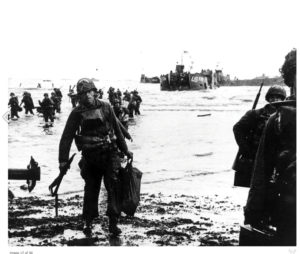Presented October 6, 1998 to The Central Mass. Chapter, VBOB, by Cliff Duxbury, historian

Frank Wooldridge is among a few WW II veterans who upstaged the draft by at least 4 years. It was in 1939 that he joined the National Guard’s 181st Infantry, 26th “Yankee” Division in Worcester and became a medic. It was a time when the Guard had limited finances, a modicum of equipment, and something less than a formalized training program.
Following the attack on Pearl Harbor on December 7, 1941 the status of Worcester’s Guard unit changed. By December 7, 1941 the 26th Division was as Federalized and Frank’s medical detachment was sent to Camp Edwards for basic training and soon after was mobilized for assignment to Coast Patrol duty to keep a watchful eye on the East Coast ranging from the Cape to Northern Maine. It was at Edwards that Frank was raised in rank to a staff sergeant. Later moving to Sacco, Maine, Frank was among a group that established an infirmary there. He moved again to Camden, Maine where he was assigned sergeant-in-charge of another infirmary.
In October 1943, he left the 181st and was sent to Camp Kilmer, New Jersey where he joined the 315th Medical Battalion, 357th Regiment, 90th Texas-Oklahoma Division. Departing New York in March 1944, the 90th reached England and Cardiff, Wales by April 9.
Intensive training followed for the infantry covering mine detection, village fighting, road marches and obstacle courses. “Invasion Fever” gripped the 90th and true to the nature of their preparation, the division moved across the Channel on June 6, 1944 —“D Day.”
Frank recalls that it took 5 long hours from Southampton before he touched down on Utah Beach with the 357th Regiment. On arrival Frank commented that the opposition on the beach was minimal but the intensity of German shelling in his landing zone continued and the medical ranks too casualties. On D plus 1, the 315th Medical Battalion set up a temporary aid station about 1/2 mile inland where casualties kept them fully occupied.
In the earliest days of the invasion, the 90th was given the mission of containing German forces trapped in the northern tip of the Normandy Peninsula. Fighting was heavy and casualties were many. The 315th Medics were kept overworked. By the end of June, however, Cherbourg, the major Normandy port in the upper peninsula, fell and the area was cleared of Germans.
At the end of July, one month later, St. Lo, Coutance and Avranches were behind the 90th. The Germans were pushed from Normandy totally and the 90th was among several divisions that reached the plains of France where a “war of Movement” began and continued almost without interruption.
Movement, heavy fighting and land advances followed for American forces when the formidable events of the Falaise Gap took place. In mid-August, 1945, it was at Falaise that German forces of the 7th Army began a full retreat and attempted to squirm through a narrow valley remaining open. The only remaining door located through the French castle town of Chambois was their chosen route. It was here that the 90th Division established road blocks to keep the Germans contained. Divisional artillery, 11 battalions strong, fired relentlessly on the bogged down Germans—inflicting heavy casualties, disrupting counter-attacks and simply pouring a hail of steel on the reeling German remnants.
And into this storm the unarmed medics of the 315th Medical Battalion performed their tasks under fire, evacuating American casualties as well as enemy wounded. A truce was eventually called in order that the wounded might be attended under less harrowing conditions and removed from the field of battle. Frank’s 315th, in spite of sniper fire, (clearly a violation of the truce terms) carried out their mission with gallantry. Working with unit doctors, Frank administered morphine to settle casualties in severe pain and administered plasma, as well, to those men who were suffering continuing blood losses. Additionally, his duties involved general first aid to GI’s preparatory to their movement to rear area hospital for more specialized handling.
By August 20, 1 944 – the Falaise Gap was closed on the bulk of the German 7th Army. 13,000 Germans surrendered to the 90th in a period of 4-days.
When in mid-December, the “Bulge” began in Belgium and Luxembourg, the 90th was ordered to disengage from the Saar River. On January 5, 1945, the division made a 50- mile convoy trek to an assembly area in Luxembourg. And in bitter, bitter cold began an assault along the perimeter of the attacking 7th German Army’s salient on the extreme southern flank of their offensive line. Fighting in an area just south and east of Bastogne, the 90th’s speed and power of assault surprised the Germans. On the 4th day of battle, the T/O division had fought their way onto Belgium soil along with the 35th and 6th Armored Divisions at their sides. The salient had been liquidated.
By January 16, the 90th straightened out their lines looking Eastward and by the 29th of January, 1945 stood on German ground for the 2nd time.
From the Bulge, battles bristled along the Siegfried Line, across the Rhine in March to points along the Czech border. On May 7 a final combat mission set to rescue Prague, the Czech capitol, was postponed when Divisional Headquarters was notified that the German High Command had surrendered.
Frank was returned to the States in Fall, 1945 to Ft. Devens where he was discharged on October 26. He rejoined the National Guard 7 years later when the Guard was looking for experienced veterans to fill their ranks. He served an additional 3 years and left the military behind him for good.
Our thanks to Frank Wooldridge for his long, faithful and vital service to his fellow GIs during World War II.
—Submitted by John McAuliffe, President, Chapter 22